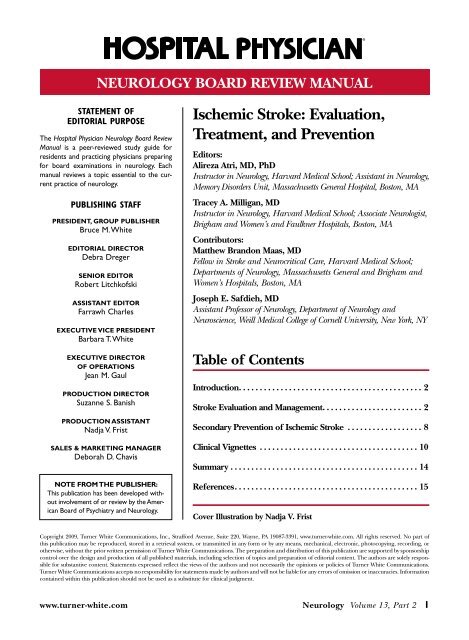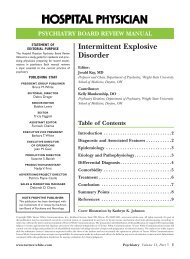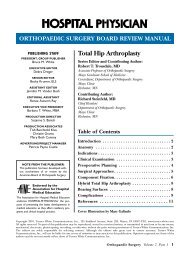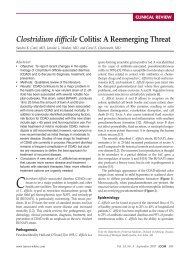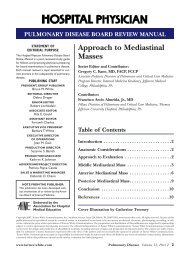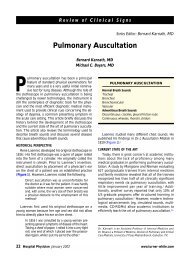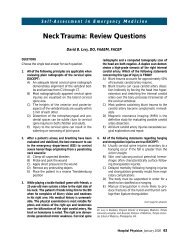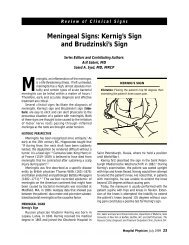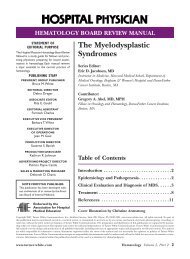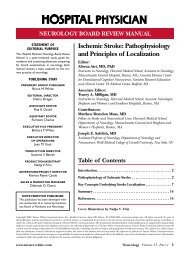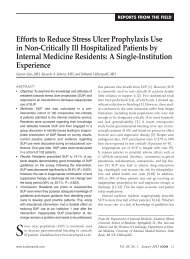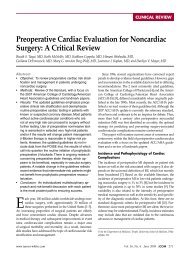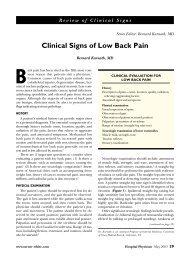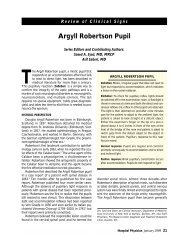Ischemic Stroke: Evaluation, Treatment, and Prevention - Turner White
Ischemic Stroke: Evaluation, Treatment, and Prevention - Turner White
Ischemic Stroke: Evaluation, Treatment, and Prevention - Turner White
You also want an ePaper? Increase the reach of your titles
YUMPU automatically turns print PDFs into web optimized ePapers that Google loves.
NEuRology BoaRd REVIEw MaNual<br />
Statement of<br />
editorial PurPoSe<br />
The Hospital Physician Neurology Board Review<br />
Manual is a peer-reviewed study guide for<br />
residents <strong>and</strong> practicing physicians preparing<br />
for board examinations in neurology. Each<br />
manual reviews a topic essential to the current<br />
practice of neurology.<br />
PuBliSHinG Staff<br />
PRESIDENT, GRouP PuBLISHER<br />
Bruce M. <strong>White</strong><br />
EDIToRIaL DIREcToR<br />
Debra Dreger<br />
SENIoR EDIToR<br />
Robert Litchkofski<br />
aSSISTaNT EDIToR<br />
Farrawh Charles<br />
ExEcuTIvE vIcE PRESIDENT<br />
Barbara T. <strong>White</strong><br />
ExEcuTIvE DIREcToR<br />
of oPERaTIoNS<br />
Jean M. Gaul<br />
PRoDucTIoN DIREcToR<br />
Suzanne S. Banish<br />
PRoDucTIoN aSSISTaNT<br />
Nadja V. Frist<br />
SaLES & maRkETING maNaGER<br />
Deborah D. Chavis<br />
NoTE fRom THE PuBLISHER:<br />
This publication has been developed without<br />
involvement of or review by the American<br />
Board of Psychiatry <strong>and</strong> Neurology.<br />
<strong>Ischemic</strong> <strong>Stroke</strong>: <strong>Evaluation</strong>,<br />
<strong>Treatment</strong>, <strong>and</strong> <strong>Prevention</strong><br />
Editors:<br />
alireza atri, Md, Phd<br />
Instructor in Neurology, Harvard Medical School; Assistant in Neurology,<br />
Memory Disorders Unit, Massachusetts General Hospital, Boston, MA<br />
Tracey a. Milligan, Md<br />
Instructor in Neurology, Harvard Medical School; Associate Neurologist,<br />
Brigham <strong>and</strong> Women’s <strong>and</strong> Faulkner Hospitals, Boston, MA<br />
Contributors:<br />
Matthew Br<strong>and</strong>on Maas, Md<br />
Fellow in <strong>Stroke</strong> <strong>and</strong> Neurocritical Care, Harvard Medical School;<br />
Departments of Neurology, Massachusetts General <strong>and</strong> Brigham <strong>and</strong><br />
Women’s Hospitals, Boston, MA<br />
Joseph E. Safdieh, Md<br />
Assistant Professor of Neurology, Department of Neurology <strong>and</strong><br />
Neuroscience, Weill Medical College of Cornell University, New York, NY<br />
Table of Contents<br />
Introduction. . . . . . . . . . . . . . . . . . . . . . . . . . . . . . . . . . . . . . . . . . . . 2<br />
<strong>Stroke</strong> <strong>Evaluation</strong> <strong>and</strong> Management. . . . . . . . . . . . . . . . . . . . . . . . 2<br />
Secondary <strong>Prevention</strong> of <strong>Ischemic</strong> <strong>Stroke</strong> . . . . . . . . . . . . . . . . . . 8<br />
Clinical Vignettes . . . . . . . . . . . . . . . . . . . . . . . . . . . . . . . . . . . . . . 10<br />
Summary . . . . . . . . . . . . . . . . . . . . . . . . . . . . . . . . . . . . . . . . . . . . . 14<br />
References. . . . . . . . . . . . . . . . . . . . . . . . . . . . . . . . . . . . . . . . . . . . 15<br />
Cover Illustration by Nadja V. Frist<br />
Copyright 2009, <strong>Turner</strong> <strong>White</strong> Communications, Inc., Strafford Avenue, Suite 220, Wayne, PA 19087-3391, www.turner-white.com. All rights reserved. No part of<br />
this publication may be reproduced, stored in a retrieval system, or transmitted in any form or by any means, mechanical, electronic, photocopying, recording, or<br />
otherwise, without the prior written permission of <strong>Turner</strong> <strong>White</strong> Communications. The preparation <strong>and</strong> distribution of this publication are supported by sponsorship<br />
control over the design <strong>and</strong> production of all published materials, including selection of topics <strong>and</strong> preparation of editorial content. The authors are solely responsible<br />
for substantive content. Statements expressed reflect the views of the authors <strong>and</strong> not necessarily the opinions or policies of <strong>Turner</strong> <strong>White</strong> Communications.<br />
<strong>Turner</strong> <strong>White</strong> Communications accepts no responsibility for statements made by authors <strong>and</strong> will not be liable for any errors of omission or inaccuracies. Information<br />
contained within this publication should not be used as a substitute for clinical judgment.<br />
www.turner-white.com Neurology Volume 13, Part 2
INTRODUCTION<br />
NeuRology BoaRd Review MaNual<br />
ischemic <strong>Stroke</strong>:<br />
evaluation, <strong>Treatment</strong>, <strong>and</strong> <strong>Prevention</strong><br />
Matthew Br<strong>and</strong>on Maas, Md, <strong>and</strong> Joseph e. Safdieh, Md<br />
This manual is the second half of a 2-part review<br />
of ischemic stroke. In part 1, the pathophysiology of<br />
stroke was reviewed from both a cellular <strong>and</strong> systemic<br />
perspective. An organized framework was developed to<br />
discuss the important characteristics of diseases implicated<br />
in causing ischemic stroke based on their mechanism<br />
of injury. Part 2 of this review provides an overview<br />
of the evaluation <strong>and</strong> management of ischemic stroke.<br />
Because of the broad heterogeneity of stroke mechanisms,<br />
strategies are presented to systematically screen<br />
for contributory risk factors. Management techniques<br />
are presented from acute stabilization to secondary<br />
prevention, covering important topics such as vascular<br />
reperfusion therapies, in-hospital care, relevant surgical<br />
procedures, <strong>and</strong> rehabilitation. This manual concludes<br />
with a series of case-based questions that apply the concepts<br />
presented throughout parts 1 <strong>and</strong> 2.<br />
STROKE EVALUATION AND MANAGEMENT<br />
<strong>Stroke</strong> care is commonly divided into 2 phases. The<br />
initial phase is the urgent time period that begins when<br />
the patient first presents to clinical attention. Because<br />
the brain is poorly resilient to deprivation of oxygen<br />
<strong>and</strong> metabolic substrates, time to intervention is critically<br />
important. The organizing principle of the initial<br />
phase of stroke care is to perform a limited evaluation<br />
with a focus on obtaining data necessary for making<br />
decisions about time-sensitive treatments. This includes<br />
an abbreviated history of the patient’s presenting symptoms<br />
<strong>and</strong> past medical history, a focused general <strong>and</strong><br />
neurologic examination, basic laboratory studies, <strong>and</strong><br />
rapid baseline neuroimaging. Stabilization <strong>and</strong> therapeutic<br />
interventions ensue during this phase of care.<br />
In the second phase, care started during the initial<br />
phase continues on an inpatient basis as a thorough evaluation<br />
of the patient is undertaken. The accumulation of<br />
additional data allows for a more accurate determination<br />
of the etiology of the ischemic event <strong>and</strong> further exploration<br />
of risk factors. Patients presenting with transient<br />
ischemic attack (TIA) are at significant risk for stroke 1<br />
<strong>and</strong> should undergo the same evaluation as patients admitted<br />
for stroke, with the intent of identifying risk factors<br />
for primary prevention. 2 A multidisciplinary approach is<br />
required to avoid further medical consequences of stroke<br />
(eg, aspiration pneumonia) <strong>and</strong> to establish a plan for<br />
rehabilitation. Outpatient care supports continuing rehabilitation<br />
efforts <strong>and</strong> ongoing risk factor modification.<br />
ACUTE EVALUATION AND STABILIZATION<br />
Several basic evaluation <strong>and</strong> management procedures<br />
should be rapidly undertaken for every patient<br />
presenting with suspected acute ischemic stroke. 3 The<br />
extent of the evaluation depends on the likelihood of<br />
encountering a positive finding, the pretest probability.<br />
For example, the pretest probability of a significant<br />
finding on a hypercoagulability panel for a stroke<br />
patient is high for a young woman with a history of<br />
thrombosis <strong>and</strong> multiple spontaneous fetal losses but<br />
low for an elderly patient with poorly controlled risk<br />
factors <strong>and</strong> a severe ipsilateral carotid stenosis.<br />
Stabilization<br />
The first step in acute stroke management is to ensure<br />
that the patient is stabilized, brought promptly to an appropriate<br />
emergency department (ED), <strong>and</strong> rapidly evaluated.<br />
It has been demonstrated that outcomes are better<br />
for patients treated at designated stroke centers. 3 As in all<br />
emergency situations, the initial approach to the patient<br />
requires a survey of the patient’s airway, breathing, <strong>and</strong><br />
circulatory function. Severe dysphasia <strong>and</strong> diminished<br />
level of arousal are not rare in acute stroke, <strong>and</strong> some patients<br />
may require intubation to protect their airway <strong>and</strong><br />
minimize aspiration. An abbreviated examination will<br />
consist of assessment of vital signs, survey for evidence of<br />
trauma, <strong>and</strong> a focused cardiovascular system assessment.<br />
History <strong>and</strong> Neurologic Assessment<br />
A neurologic assessment should be sufficiently thorough<br />
to identify major deficits. Use of a st<strong>and</strong>ardized<br />
Hospital Physician Board Review Manual www.turner-white.com


